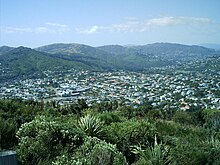Karori
| Karori | |
|---|---|

City-end Karori from Wrights Hill summit
|
|
| Basic information | |
| Local authority | Wellington City |
| Electoral ward | Onslow-Western |
| Date established | 1840 |
| Land area | 1,726 ha (6.66 sq mi) |
| Coordinates | 41°17′05″S 174°44′12″E / 41.284855°S 174.736795°ECoordinates: 41°17′05″S 174°44′12″E / 41.284855°S 174.736795°E |
| Population | 14,736(2013) |
| Postcode(s) | 6012 |
| Surrounds | |
| Northeast | Wilton |
| East | Northland |
| Southeast | Highbury, Taitville |
| Northwest | Makara |
Karori is a suburb located at the western edge of the urban area of Wellington, New Zealand, 4 km from the city centre and is one of New Zealand's biggest suburbs having a population of over 14,000 at the time of the 2013 census.
The name Karori means ‘the rope of bird snares’ in Te Reo Māori.
The area was uninhabited by Māori when the first European settlers came to Karori in the 1840s, having bought the land from the New Zealand Company. The first settler in Karori was John Yule of Glasgow, who cleared 20 acres of forest on his section with his younger brother Moses and advertised its sale in December 1841. By 1845, ten 100-acre sections were being taken up and sub-divided and Karori recorded 215 inhabitants – 109 of them under the age of 14 years.
A small fortified post was constructed in 1845 by a group of armed police from Wellington that became known as “The Stockade” in response to fears of attacks from nearby Māori insurgents. While there were no attacks, the stockade was used for a church service and was used to grind grain.
The first mental hospital in Wellington was built in 1854. By 1871 it had 23 inmates and was run by untrained staff which resulted in the first matron and her husband being dismissed in 1872 because of cruelty. In 1873 the asylum was moved from Karori to the site of present-day Government House. The asylum site was taken over by Karori school in 1875.
Karori in the 1850s was described by Frederick Mackie in his book "Traveller under concern":
Karori experienced a gold rush when the valley of the Upper Kaiwharawhara Stream was subject to intensive gold mining activity between 1869 and 1873. This activity eventually led to the building of the lower Karori Dam in 1873. At the height of the rush, there were about 200 men working the claims, and shafts and drives up to 500 feet in length were driven into the hills.
In 1888, section 34, which was the closest to town running from present day Ponsonby Road to Cooper Street, was purchased by a syndicate and prepared for sale by building roads and naming them after the members of the syndicate and their families. A marketing campaign was run, including free buses from Manners Street and poems written:
"In far-famed New Zealand, the evergreen free land
Most favoured and beautiful Queen of the wave,
Where the sun ever smiling, bad weather beguiling,
Brightly shines on the face of the honest and brave.
Tho' for Europe's bold races there are plenty of places
Adapted as homes for the great and the small,
Yet, for onward progressing and bountiful blessing
There is one whose position is far before all.
So haste where kind Nature's arrayed in her glory,
To pleasant, romantic, suburban Karori."
...
Wikipedia

